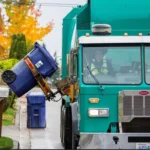
Environmental Services
Tacoma’s Environmental Services Department is dedicated to protecting public health and the environment through essential services like garbage and recycling collection, wastewater treatment, stormwater management, and climate action planning. By ensuring clean water, reducing pollution, and promoting sustainable practices, we are committed to ensuring healthy neighborhoods and a thriving Puget Sound – leaving a better Tacoma for all.
Learn more about the utility services and other programs that the Environmental Services Department provides.
Contact Us
-
Please call Customer Service for any of the following:
- wastewater, surface water and solid waste billing inquires
- to request a change of service
- to request replacement containers
- to schedule a Call-2-Haul appointment
- to report missed pick-ups
- questions regarding drop-off boxes
Customer Service is available Monday - Friday from 9 a.m. to 4 p.m.
Phone: (253) 502-8600 -
For power/electricity inquiries or water inquiries please call the number below. For information about payment options, starting, and stopping service, credit and deposit policies, utility bill assistance and business hours for Tacoma Power and Tacoma Water, visit Tacoma Public Utilities online.
Tacoma Public Utilities
Phone: (253) 502-8600 -
For life-threatening emergencies, please dial 911. For other urgent issues related to sewer backups, storm drain flooding, or pollution concerns, contact our 24-hour emergency lines listed below.
- Sewer Backups: (253) 591-5585
- Storm Drain Flooding: (253) 591-5585
- Pollution Hotline: (253) 383-2429 (Leave a confidential message 24 hours/day)
- 24-Hour Emergency Line: (253) 591-5585
24-Hour Emergency Line
Phone: (253) 591-5585 -
The Environmental Services Director oversees the City’s Wastewater, Stormwater, and Solid Waste utilities and is located in the Center for Urban Waters building. For power or water inquiries, please contact TPU directly.
Environmental Services Director's Office
Phone: (253) 591-5588Fax: (253) 591-5300
Meet the Director
-
Ramiro A. Chavez, P.E. PgMP
-
 Environmental Services Director & City Engineer
Environmental Services Director & City EngineerRamiro A. Chavez, P.E. PgMP
Ramiro Chavez currently serves as the Director of Environmental Services and City Engineer for the City of Tacoma, a role he assumed in June 2025. Director Chavez oversees the Wastewater, Surface Water, and Solid Waste utilities, which collectively employ nearly 550 staff and operate with a biennial budget exceeding $450 million. Prior to this, he served as the City’s Public Works Director. With more than 30 years of experience in public service, Director Chavez has built a distinguished career in utility services, public works, architecture, public administration, and project management.
Prior to joining the City of Tacoma, Ramiro served as the County Manager for Thurston County, where he oversaw the Public Works, Public Health, Social Services, and Economic Development departments. Ramiro began serving as County Manager for Thurston County in an interim capacity, starting in June 2016, and in a permanent capacity starting in February 2017. Ramiro joined the City of Tacoma as a part of his return to his passion for public works.
Ramiro’s background in public infrastructure and municipal management is extensive. As Public Works Director for Thurston County, he was responsible for utility services – including sewer, water, stormwater, and solid waste – as well as the development and maintenance of public spaces, transportation systems, and parks. Earlier in his career, he served as Transportation Division Manager for Pierce County’s Public Works Department, where he led major transportation initiatives and planning efforts.
Education
Architecture Degree, Central University of Ecuador
Professional Affiliations
- American Public Works Association (APWA)
- American Society of Civil Engineers (ASCE)
- Institute of Transportation Engineers (ITE)
- International City/County Management Association (ICMA)
- Project Management Institute (PMI)
Professional Licensing/Registrations
- Licensed Professional Engineer (Washington)
- Program Management Professional (PMI)
Find us on Social Media
We’re hiring in Environmental Services! 💧🌿
Join a mission-driven team keeping Tacoma clean, green & thriving. Whether you're into soil science, lab work, or learning the ropes at a wastewater treatment plant — we’ve got something for you.
✨ Open Positions:
...
🚛 TAGRO Biosolids Distribution Operator
Help deliver award-winning soil blends! CDL experience preferred.
🧪 Environmental Lab Scientist-in-Training
Great for early-career scientists! Lab work, data & sampling.
⚡️ WWTP Electrician/Instrumentation Tech
Keep essential systems running with skilled electrical maintenance.
💧 WWTP Operator-in-Training
New to wastewater? Get paid to learn on the job!
Apply today - 🔗Link in bio or visit tacoma.gov/jobs
We’re hiring in Environmental Services! 💧🌿
Join a mission-driven team keeping Tacoma clean, green & thriving. Whether you're into soil science, lab work, or learning the ropes at a wastewater treatment plant — we’ve got something for you.
✨ Open Positions:
...
🚛 TAGRO Biosolids Distribution Operator
Help deliver award-winning soil blends! CDL experience preferred.
🧪 Environmental Lab Scientist-in-Training
Great for early-career scientists! Lab work, data & sampling.
⚡️ WWTP Electrician/Instrumentation Tech
Keep essential systems running with skilled electrical maintenance.
💧 WWTP Operator-in-Training
New to wastewater? Get paid to learn on the job!
Apply today - 🔗Link in bio or visit tacoma.gov/jobs
🌊Learn what Tacoma’s new Stormwater Plan means for your neighborhood and how the Stormwater Comprehensive Plan will guide efforts to reduce flooding, improve water quality, and protect local habitat.
➡️Online Workshop
Monday, July 29 | 12:00 – 1:00 PM
Register at ...bit.ly/44xg8zf or click the link in our bio
We want your feedback on the SWCP’s commitments and vision to help make our neighborhoods and waterways healthier.
Scan the QR code to learn more about the project and how to get involved!




